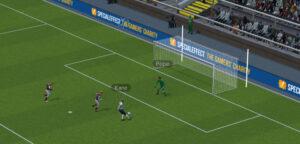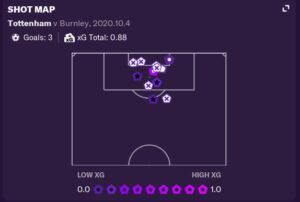
Goalkeeper Resiliency: Measuring Game Difficulty
One of the most interesting things available in Football Manager 2021 is the ability to track expected Goals, or xG. In combination with Pelham, I think I’ve worked out a useful way to measure what I’m going to call Goalkeeper Resiliency (GR), that is, the degree of difficulty that a goalkeeper is facing, relative to that normally faced by goalkeepers in their league.
The Theory of Goalkeeper Resiliency
The thinking behind the theory is that a goalkeeper is using up mental and physical energy every time a sho t is taken, whether it is on target or not. Seeing a player shape up to shoot, you measure angles, check positioning, get on your toes, get your arms out, and try to judge the shape of the player’s body to help predict the shot.
t is taken, whether it is on target or not. Seeing a player shape up to shoot, you measure angles, check positioning, get on your toes, get your arms out, and try to judge the shape of the player’s body to help predict the shot.
The idea comes from a 1986 book on ice hockey statistics that introduced a stat called “Perseverance”, which attempted a similar idea. It was flawed, because shots weren’t differentiated as to where they were taken from, or their general danger level, but the concept was the birthplace of the stat I’m proposing today.
To measure this in football, I’m proposing that we use an existing stat in a different way: xGA, or “expected goals against”. This would be, for a goalkeeper, the cumulative difficulty of shots they faced. It won’t be a perfect measure, but it should give us something we can use to compare.
But a raw examination of xGA wouldn’t tell us much, because we have nothing to compare it to. The obvious comparison is the other goalkeepers in the same division: average the xGA in every game, and use that to compare to the xGA of the game being examined.
So what we’ve g ot so far is (xGA/LgeAvexGA), which will give us a high number if the game was difficult, and a number less than 1 if it was notably easy.
ot so far is (xGA/LgeAvexGA), which will give us a high number if the game was difficult, and a number less than 1 if it was notably easy.
Applying the Math of Goalkeeper Resiliency
The key question then is how to use that generated number, that GR (Goalkeeper Resiliency). I believe the best use is to modify a more conventional stat, like Goals Against Average. This is a simple measure, like Conceded/90, that tells you how many goals a keeper gives up per game. As a raw stat, it’s marginally useful, but has no way of coping with the difference in difficulty of a given game.
To show how this would work, I’ll put up three scenarios here. For all three scenarios, the league average expected goals against is 2.8.
Scenario A
In the first scenario, the goalkeeper gave up just one goal, despite the xGA being 4.9. This is an excellent performance.
Scenario B
In this one, the goalkeeper conceded two goals, while  the xGA was only 0.4. This is a very poor performance.
the xGA was only 0.4. This is a very poor performance.
Scenario C
In the third, the keeper concedes two goals, while the xGA was also 2.0.
Doing the Math
So, in order to get the Adjusted GAA (or AGAA), we take the GAA for each scenario. These are respectively 1.00, 2.00, and 2.00 for A, B, and C. We then divide it by the Goalkeeper Resiliency number, which we can derive (as shown above) by xGA/LAxGA.
In A, we have 4.9/2.8, or 1.75. So the AGAA is 1.00/1.75, or 0.57.
In B, we have 0.4/2.8, or 0.14. The AGAA is 2.00/0.14, or 14.00.
In C, we have 2/2.8, 0.71. The AGAA is 2.00/0.71, or 2.80.
So the goalkeepers gave up 1, 2, and 2 goals, but their AGAA is wildly different. For GK A, who faced a plethora of good goalscoring chances, his AGAA is 0.57, considerably better than his GAA of 1.00. GK B is looking quite shockingly bad to have conceded a 14.00 AGAA, which is a lot worse than his GAA of 2.00. And the last goalkeeper has given us a league average sort of AGAA, at 2.80, compared to his GAA of 2.00.
We can see that the AGAA more accurately reflects the performance of the keepers, given how difficult the game they faced was. While their GAA were fairly similar – ranging from 1.00 to 2.00 – their AGAA show that some of them faced much harder games.
Conclusion
So that’s my proposed new measure. What do you think? Does it capture what it’s intended to capture? Is there a better way to do it? I’d love to have a discussion about it, if you have any thoughts or comments.
You can find Dictate the Game online at:
If you liked the article you can find some more below, and our podcast on anchor and other platforms.
- Expected Assists: xA and Received Passes in FM20
- Inter the Game
- Unsung Heroes: Raumdeuter
- Total Football Journeyman: Bossing the Ball like 1995 Ajax
7 thoughts on “Goalkeeper Resiliency: Measuring Game Difficulty”
You could also modify the GAA to exclude own goals, as these typically come as a result of situations where a keeper is not beaten by the opponent but by a deflection off a team mate.
That’s an excellent point, thank you, I’ll put that into the idea.
Is there any way to get the xG from any match in league?
I believe if you go to the schedule of a team, open up a game, and click on “Analysis Data”, it will load the data from that game and allow you to see the xG from that game.
Nice topic.
However dont’t you think that in order to assess the keeper you have to sort out xG from shots on target only ?
That is a possibility, but my reasoning is that whenever a player sets up to shoot, the goalkeeper must focus and prepare, and that this is no different for shots that miss than it is for shots that don’t. Since I’m looking at this exclusively from the keeper’s point of view, I think it’s valid to keep all the shots in there, because one way or the other, the keeper had to deal with them all. Thanks for your comment!
Something goes wrong. Cannot see any comment.